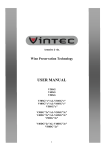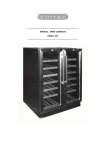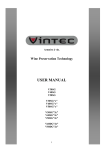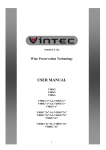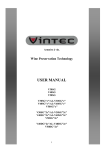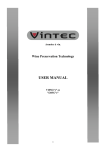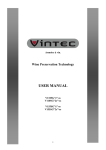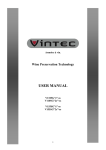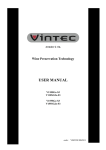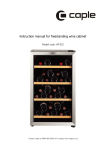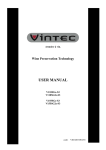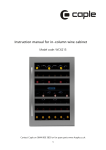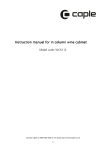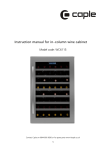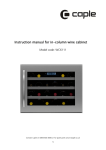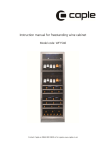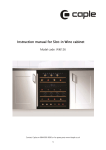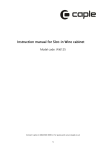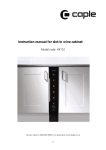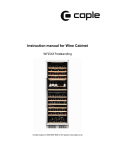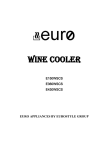Download Vintec V50DG 2e User manual
Transcript
Wine Preservation Technology USER MANUAL MODEL V50DG “2e” 1 WARNING The information in this document is subject to modification without any prior notice. VINTEC offers no guarantee for our wine cellar if it is being used for any purpose other than that for which it was specifically designed. VINTEC cannot be held responsible for any error in this manual. VINTEC is not responsible or liable for any spoilage or damage to wines or any other contents incidental or consequential to possible defects of the wine cellar. Guarantee applies to the wine cellar only and not the contents of the wine cellar. This document contains original information, protected by copyright. All rights are reserved. All photocopying, reproduction, translation whether partial or total are strictly prohibited, without prior written consent from VINTEC. This appliance is not intended for use by young children or infirm persons unless they are adequately supervised by a responsible person to ensure they are capable of using the appliance safely. Young children should be supervised to ensure they do not play with this appliance. Allow 24 hours before switching on the wine cellar. During this time we recommend that you leave the door open to clear any residual odors. BEFORE LOADING & PLUGGING IN THE WINE CELLAR Important : All models without front venting (air opening) are strictly for free standing only. Recommendations: The location you have selected for your wine cellar should : - be unencumbered and well ventilated; - be well away from any heat source and direct sunlight; - not be too damp (laundry, pantry, bathroom etc.); - have a flat floor; and - have a standard and reliable electricity supply (standard socket to country standards, linked to the ground), it is NOT recommended to use a multi-socket or extension lead. The wine cellar should be placed where the ambient temperature is between 0ºC -38ºC. If the ambient temperature is above or below this range, the performance of the unit may be affected. For example, placing your unit in extreme cold or hot conditions may cause interior temperatures to fluctuate. The ideal range of temperature may not be reached. 2 Installing your wine cellar Unpack and remove all of the protection and adhesive strips from the packaging around and inside the wine cellar. The wine cellar must be positioned such that the plug is accessible. Release the power cord. Move your wine cellar to its final location. The wine cellar should be installed in a suitable place where the compressor will not be exposed to manual contact. Grounding instructions The wine cellar must be grounded in case of an electrical short circuit. Grounding reduces the risk of electrical shock. The wine cellar is equipped with a power cord having a grounding wire and grounding plug. The wine cellar plug must be plugged into a properly installed and grounded electrical outlet. Note : In locations where there is frequent lightning, it is advisable to use surge protectors. Improper use of the grounding plug can result in the risk of electric shock. Consult a qualified electrician or service person if the grounding instructions are not completely understood. If the supply cord is damaged, it must be replaced by its service agent or a similarly qualified person in order to avoid a hazard. Leveling your wine cellar Important: Wine cellar must be leveled BEFORE loading your wines. Your wine cellar is equipped with 4 adjustable feet to facilitate easy leveling. VINTEC recommends that you tighten the back feet to the maximum and adjust the front feet to create a level. TURNING ON YOUR WINE CELLAR Plug in and switch on the cellar. Important: If the unit is unplugged, power is lost, or turned off, you must wait 3 to 5 minutes before restarting the unit. The wine cellar will not start if you attempt to restart before this time delay. Note: When you use the wine cellar for the first time or restart the wine cellar after having been shut off for a long time, there could be a few degrees’ variance between the 3 temperature you have selected and the one indicated on the LED readout. This is normal and it is due to the length of the activation time. Once the wine cellar is running for a few hours everything will be back to normal. Operating Noises To reach the desired temperature settings, VINTEC wine cellars, like all wine cellars operating with compressors and fans, may produce the following types of noises. These noises are normal and occur as follows: - Gurgling sound, caused by the refrigerant flowing through the appliance’s coils; - Cracking/popping sounds, resulting from the contraction and expansion of the refrigerant gas to produce cold; and - Fan operating sound, to circulate the air within the wine cellar. An individual’s perception of noise is directly linked to the environment in which the wine cellar is located, as well the specific type of models. VINTEC wine cellars are in line with international standards for such appliance. VINTEC will always do its utmost to satisfy its customers but will not retake possession of the goods due to complaints based on normal operating noise occurrences. LOADING YOUR WINE CELLAR You may load your wine bottles in single or double rows while taking note of the followings: - Avoid obstructing the internal fans (located inside on the back panel of the wine cellar). Keep a small gap between the wall and the bottles. - Do not try to slide the shelves outwards beyond the fixed position to prevent the bottles from falling. - Do not pull out more than one loaded shelf at a time as this may cause the wine cellar to tilt forward. - Do not cover the wooden shelves with alloy foil or other materials, as it will obstruct air circulation. You should note that if you do not have enough bottles to fill your wine cellar, it is better to distribute the load throughout the wine cellar so as to avoid “all on top” or “all below” type loads. Important: DO NOT move your wine cellar while it is loaded with wines. This might distort the body of the wine cellar. 4 TYPES OF REGULATION One-Temperature Maturing/Storage Wine Cellars: - Standard regulation - “e” series : electronic regulation, digital display Designed to store and mature all wines: red, white and sparkling. These wine cellars reproduce the ideal conditions for wine storage, at a constant recommended temperature of 12ºC. They can also be set to provide ideal serving temperature for full enjoyment of the wine’s qualities. Unless stated by the wine maker on the bottle, VINTEC recommends 7ºC for your champagne, 12ºC for whites and 18ºC for reds. (Refer to “Wine Service Temperature” section at the end of manual). Two-Temperature Serving Wine Cellar (2-in-1 Wine Cellars): - “2e” series : electronic regulation digital display Equipped with 2 compartments, the 2-temperature models are designed to keep wine at the correct temperature for both enjoyment and storage. Two different temperatures from 5ºC to 18ºC can be set at any one time. TEMPERATURE SETTINGS Important: The LCD displays by default the actual internal air temperature. The temperature settings are pre-set at the factory at: the left compartment is 7ºC and the right compartment is 12ºC . Note: In the event of a power interruption, all previous temperature settings are automatically erased and it will revert to a preset temperature setting of left compartment 7ºC and right compartment 12ºC . The setting values are not in degree Celsius but in index values. An index value is roughly equivalent to 1ºC You will need to wait approximately 12 hours before noticing the effects of temperature adjustment due to the critical mass within a full wine cellar. Once the thermostat is set it is strongly advised not to toy with it or adjust frequently. The thermostat will maintain the temperature inside the wine cellar within a +/- 2.5ºC. The thermal inertia of the wine and the glass is such that within this temperature range, the actual temperature of the wine will only fluctuate 0.5ºC to 1ºC. It is important to understand that 5 there is a difference between the air temperature inside the wine cellar and the actual temperature of the wine. Control panel of your wine cellar (Left compartment) C UP RUN DOWN DISPLAY LIGHT POWER (Right compartment) C RUN UP DOWN DISPLAY LIGHT POWER • RUN Indicator light illuminates to signify the cooling mode is currently in operation. • LIGHT • To control the inner light, turn on/off. Both compartment lights will automatically turn on when opening anyone of the doors. • POWER To control this appliance, turn on/off. • “UP” to raise (warmer) the temperature. • “DOWN” to lower (cooler) the temperature. To modify the pre-set temperature Adjust the desired cooling temperature by pressing the UP or DOWN buttons. Each depression of the buttons will scroll through the available temperature settings in increments of 1 degree Celsius. The temperature selected will flash in the LED display for approximately 5 seconds and then revert to displaying the temperature of the internal cabinet. The temperature setting for both compartments can be adjusted from 5℃ to 18℃. Adjusting/removing the shelves For easy access to the storage content, you must pull the shelves approximately 1/3 of its depth out of the rail compartment. This unit is, however, designed with a notch on each side of the shelf tracks to prevent bottles from falling. 6 When removing any of these shelves out of the rail compartment, tilt the shelf as per the diagram and simply pull out, or push the shelf in until it sits on the support brackets securely. HOW TO REPLACE LED LIGHT: 1: Remove the electrical box from cabinet. ( Note: cut off the power firstly when removing LED light) 2: Remove the LED light from control board. (Fig. 1) 3: According to ( Fig.2、3、4), press the four buckle of the LED light bracket to the sides, then take out the LED light 4: When removing the LED light, remember to remove the all three pieces LED light at one time Installation specifications for built-in purposes 7 Front View Side View Top View DEFROSTING/CONDENSATION/ HYGROMETRY/ VENTILATION Your wine cellar is designed with “Auto-cycle” defrost system. During “Off-cycle” the refrigerated surfaces of the wine cellar defrost automatically. Defrost water from the wine cellar storage compartment drains automatically and part of it goes into a drainage container, which is located at the back of the wine cellar next to the compressor. The heat is transferred from the compressor and evaporates any condensation that has collected in the pan. Part of the remaining water is collected within the wine cellar for humidity purposes. This system enables the creation of the correct humidity level inside your wine cellar required by the natural cork to maintain a long lasting seal. Notes: The water collected by condensation, is therefore recycled. Under extremely dry environmental conditions, you may have to add some water into the water container provided with your wine cellar. All units are equipped with a double glazed glass door that has a third internal acrylic layer to minimize condensation on the glass door as well as to provide a thermal barrier. Notes: During the refrigerating cycle, heat is given off. Avoid touching the external surfaces of the wine cellar as they can be hot – these units have skin membranes to disperse heat. The wine cellar is not totally sealed; fresh air admission is permitted through the drainpipe. Air is circulated through the cellar by means of a fan/fans and the hollow shelves. 8 POWER FAILURES Most power failures are corrected within a short period of time. An hour or two’s loss of power will not affect your wine cellar’s temperatures. To avoid sudden change of temperature while the power is off, you should avoid opening the door. For longer period of power failure, do take steps to protect your wine. Irrespective of the cause, if you notice either abnormal temperature or humidity levels inside your wine cellar, be reassured that only long and frequent exposure to these abnormal conditions can cause a detrimental effect on your wines. OPERATION ANOMALIES Ensure that there is power to the electrical supply plug by connecting another electrical appliance to it. Check fuse, if any. If your wine cellar appears to be malfunctioning, unplug it and contact your VINTEC’s after sales service. Any intervention on the cold circuit should be performed by a refrigeration technician who should carry out an inspection of the circuit sealing system. Similarly, any intervention on the electrical circuit should be performed by a qualified electrician. Note : Any intervention performed by a non-technician will lead to the warranty being considered as null and void. 9 WINE SERVING TEMPERATURE (Indicative only) Champagne NV, Sparkling, Spumante 6ºC Dry White Semillon, Sauvignon Blanc 8ºC Champagne Vintage, 10ºC Dry White Chardonnay 10ºC Dry White Gewürztraminer, Riesling, Pinot grigio 10ºC Sweet White Sauternes, Montbazillac, Ice Wine, Late Harvest 10ºC Beaujolais 13ºC Sweet White Vintage Sauternes 14ºC White Vintage Chardonnay 14ºC Red Pinot Noir, 16ºC Red Grenache, Syrah 16ºC Red Vintage Pinot Noir 18ºC Cabernet & Merlot: French, Australian, New Zealand, 20ºC Chilean, Italian, Spanish, Californian, Argentinean… Vintage Bordeaux, Vintage Rioja, Room temperature not exceeding 20ºC Vintage Barolos, Montalcino… IMPORTANT INFORMATION ABOUT TEMPERATURE Your VINTEC wine cellar has been designed to guarantee optimum conditions for storing and/or serving your wines. Fine wines require long and gentle developments and need specific conditions in which to reach their full potential. All wines mature at the same temperature, which is a constant temperature set between 12ºC and 16ºC. Only the temperature of “dégustation” (wine appreciation) varies according to the type of wines (see “Wine Serving Temperature” above). This being said and as it is for natural cellars used by wine producers for long period of storage, it is not the exact temperature that is important, but its consistency. In other words, as long as the temperature of your wine cellar is constant (between 12ºC and 16ºC) your wines will be stored in perfect conditions. Note: Not all wines will improve over the years. Some should be consumed at an early stage while others have tremendous ageing capability. All wines have a peak in maturity. Please check with your wine provider to get the relevant information. 10 www.vintec-cellar.com 11











